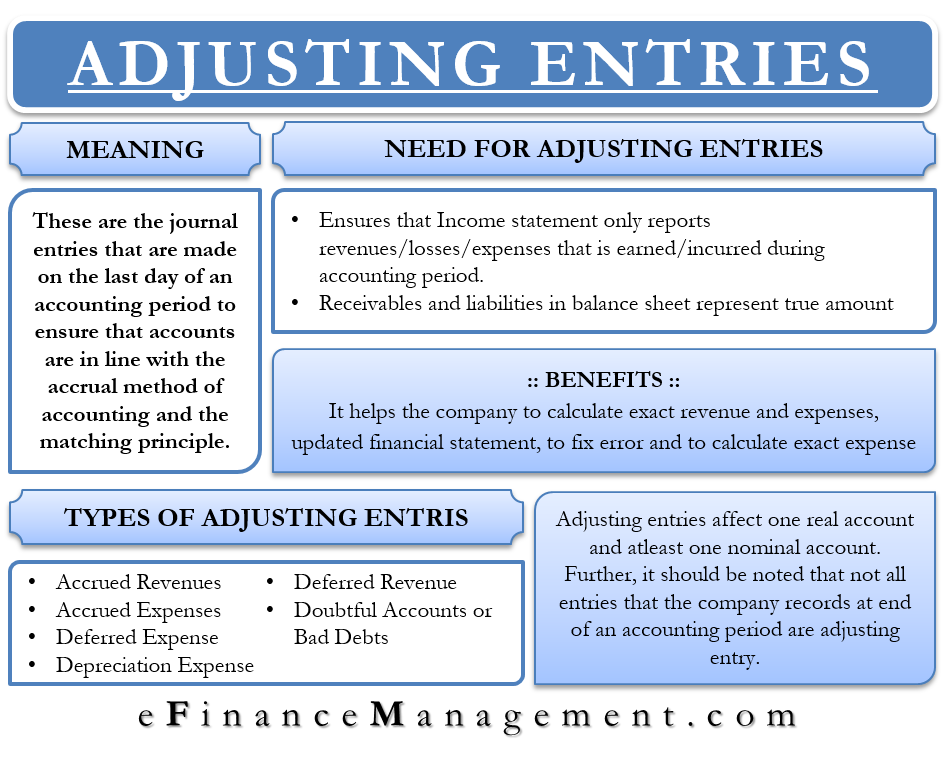Organizations usually make Adjusting Entries on the last day of an accounting period to ensure that the accounts are in line with the accrual method of accounting and the matching principle. As per the accrual concept, a company should recognize income when it earns and not when it receives. Similarly, the company should recognize the expense when it incurs and not when it pays for it. On the other hand, the matching principle says the company should recognize the expenses when it recognizes the revenue it generates from such expenses.
Adjusting entries are the journal entries and are part of the accounting cycle. Companies usually go for such entries after making the trial balance. If the trial balance does not match, these entries help the company fix the discrepancy.
Towards the end of the accounting period, there are income and expenses that a company needs to record or update. Thus, these entries help the company to record or update accounts. If the company fails to give adjusting entries, a few incomes, assets, and liability may not reflect their true values in the financial statements.
What’s the Need?
Adjusting Entries helps to ensure;
- The income statement of the company only reports revenues that the company earns during the accounting period.
- Receivables in the balance sheet reflect the true amount that the company has the right to receive at the end of the accounting period.
- The income statement includes the expenses and losses that a company incurs during the accounting period.
- The balance sheet consists of the liabilities that the company incurs as of the end of the accounting period.
Adjusting Entries helps a company:
- To calculate exact revenues and expenses.
- Update financial statements.
- To fix an error.
Examples of When Adjusting Entries Are Needed
- If a company ships goods on credit but doesn’t process the sales invoice at the end of the accounting period.
- A company receives goods from a supplier who didn’t send the invoice at the end of the accounting period.
- A company pays advance tax for the next accounting period.
- Suppose a company prepares an income statement on a monthly basis. And, it pays for six months of insurance in the first month only. In this case, in the first month, the company will show five months of insurance as prepaid.

Types of Adjusting Entries
Adjusting entries are primarily of six types:-
Accrued Revenues
These entries help a business report all the revenues it earns during the accounting period. There might be a case when a company has already provided a service but has not yet received the payment for the same. So, accrual type adjusting entries are shown in the financial statements to account for such revenues.
Accrued Expenses
Just like the accrued income or revenue, a company should only record the expenses that it incurs. A business must report an expense even if it does not pay for it. Take, for example, a company that hires a worker on a contract basis. The company expects to get an invoice on January 2nd and remit the payment on January 10th. However, the services of the worker were availed in December. Therefore, the company needs to account for the expense and liability as on December 31.
Deferred Expense
Deferred expenses are the payment made in the present for future expenses. One must refer to these payments as deferred until the expenses expire or the company avails of the service. For example, a company pays $10000 on December 25 towards vehicle insurance for the six months starting January 1. This means the insurance is prepaid for a period between December 25th and December 31.
Read more at Accrual vs. Deferral.
Depreciation Expense
It is in relation to the use of a fixed asset in the business. Examples of fixed assets are machinery, equipment, vehicles, furniture, etc. Usually, a company depreciates an asset at a certain rate that has a useful life for more than one year. Through depreciation, the company allocates the cost of the asset as an expense in the accounting periods in which the company uses the asset. For instance, a machine costing $50000 with no salvage value and useful life of 20 years will result in a monthly depreciation expense of $50000/240 (20*12).
Deferred Revenue
If the company receives any amount as an advance before earning, it should mention it as a liability in the current accounting period. For instance, a company gets an advance of $5000 for offering a service that it will provide at a later date. As on December 31st, the company should determine the portion of the service it has already delivered. This portion will come as income, and the balance will be deferred revenue.
Also Read: Closing Entries
Doubtful Accounts or Bad Debts
Not all debtors pay their dues. To account for this, the company makes provisions for bad debts, and it needs to update the balance regularly to account for more bad debt or bad debt-making payments.
Composition
Adjusting entries affect one real account and at least one nominal account. For the real account (or permanent accounts or balance sheet accounts), an accountant measures the balance cumulatively. A few examples of real accounts are Cash, Capital, Rent Receivable, and more.
For nominal accounts (temporary accounts or income statement accounts), an accountant measures the balance from period to period. It includes all accounts in the Income Statement and the owner’s withdrawal. Some examples are Salary expenses, Rent Expenses, Drawings, and more.
Note that not all entries that the company records at the end of an accounting period are adjusting entries. For instance, an entry for sale on the last day of the accounting period does not make it an adjusting. Remember, an adjusting entry will always affect income or expense account one (nominal account).


Thanks sir
I think now I understand this clearly